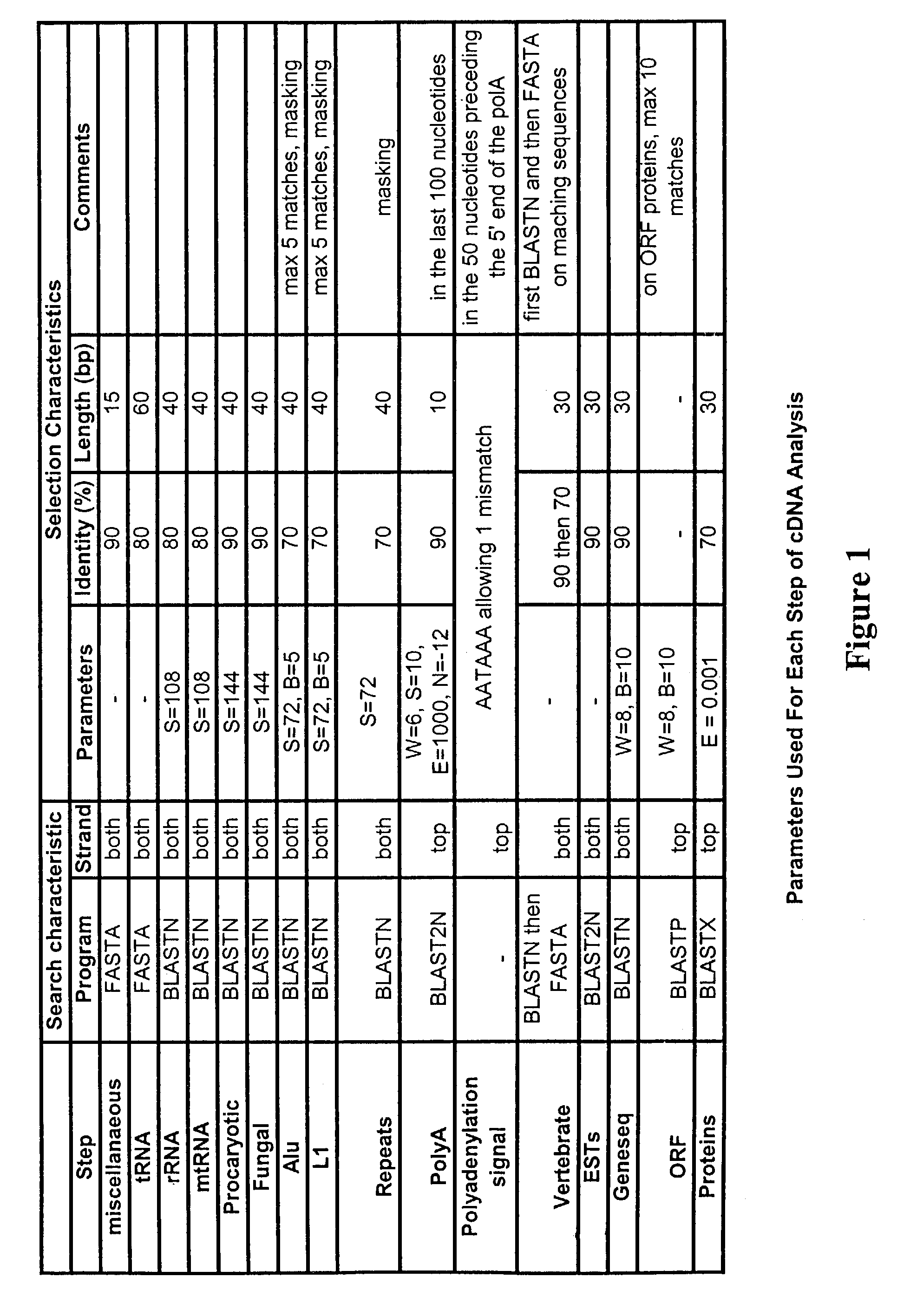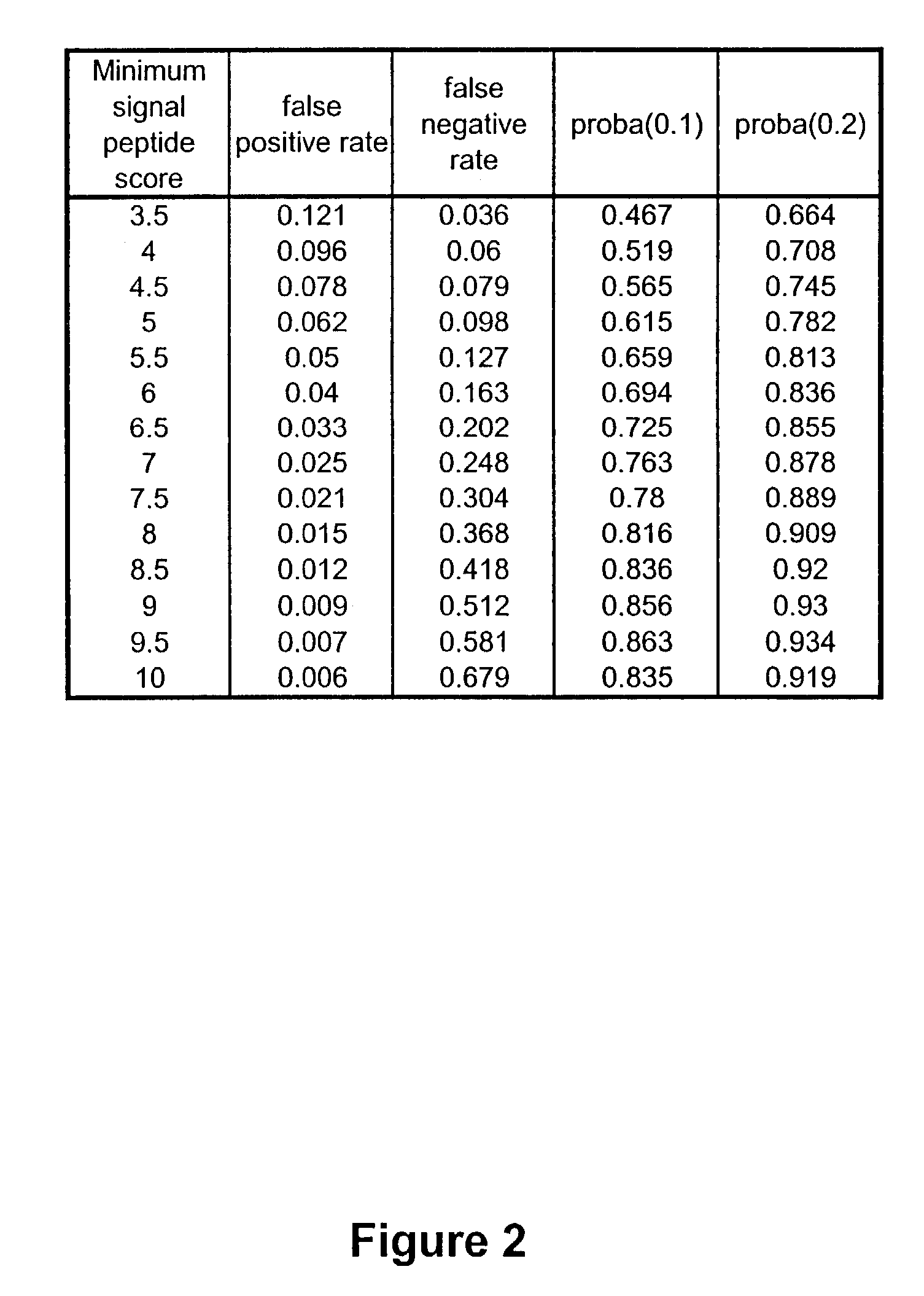Complementary DNAs encoding proteins with signal peptides
a technology of signal peptides and dnas, which is applied in the field of complementary dnas encoding proteins with signal peptides, can solve the problems of requiring years of effort, unable to achieve and typical techniques for obtaining cdnas, etc., to achieve the effect of facilitating the purification of desired proteins
- Summary
- Abstract
- Description
- Claims
- Application Information
AI Technical Summary
Benefits of technology
Problems solved by technology
Method used
Image
Examples
example 1
Preparation of mRNA
[0115]Total human RNAs or polyA+ RNAs derived from different tissues were respectively purchased from LABIMO and CLONTECH and used to generate cDNA libraries as described below. The purchased RNA had been isolated from cells or tissues using acid guanidium thiocyanate-phenol-chloroform extraction (Chomczyniski and Sacchi, Analytical Biochemistry 162:156-159, 1987). PolyA+ RNA was isolated from total RNA (LABIMO) by two passes of oligo dT chromatography, as described by Aviv and Leder, Proc. Natl. Acad. Sci. USA 69:1408-1412, 1972) in order to eliminate ribosomal RNA.
[0116]The quality and the integrity of the polyA+ RNAs were checked. Northern blots hybridized with a probe corresponding to an ubiquitous mRNA, such as elongation factor 1 or elongation factor 2, were used to confirm that the mRNAs were not degraded. Contamination of the polyA+ mRNAs by ribosomal sequences was checked using Northern blots and a probe derived from the sequence of the 28S rRNA. Preparat...
example 2
Methods for Obtaining mRNAs having Intact 5′ Ends
[0117]Following preparation of the mRNAs from various tissues as described above, selection of mRNA with intact 5′ ends and specific attachment of an oligonucleotide tag to the 5′ end of such mRNA is performed using either a chemical or enzymatic approach. Both techniques take advantage of the presence of the “cap” structure, which characterizes the 5′ end of intact mRNAs and which comprises a guanosine generally methylated once, at the 7 position.
[0118]The chemical modification approach involves the optional elimination of the 2′,3′-cis diol of the 3′ terminal ribose, the oxidation of the 2′,3′, -cis diol of the ribose linked to the cap of the 5′ ends of the mRNAs into a dialdehyde, and the coupling of the dialdehyde to a derivatized oligonucleotide tag. Further detail regarding the chemical approaches for obtaining mRNAs having intact 5′ ends are disclosed in International Application No. WO96 / 34981, published Nov. 7, 1996, the disc...
example 3
cDNA Synthesis Using mRNA Templates having Intact 5′ Ends
[0121]For the mRNAs joined to oligonucleotide tags using either the chemical or the enzymatic method, first strand cDNA synthesis was performed using reverse transcriptase with an oligo-dT primer or random nonamer. In some instances, this oligo-dT primer contained an internal tag of at least 4 nucleotides which is different from one tissue to the other. In order to protect internal EcoRI sites in the cDNA from digestion at later steps in the procedure, methylated dCTP was used for first strand synthesis. After removal of RNA by an alkaline hydrolysis, the first strand of cDNA was precipitated using isopropanol in order to eliminate residual primers.
[0122]The second strand of the cDNA was then synthesized with a Klenow fragment using a primer corresponding to the 5′ end of the ligated oligonucleotide. Preferably, the primer is 20-25 bases in length. Methylated dCTP was also used for second strand synthesis in order to protect i...
PUM
| Property | Measurement | Unit |
|---|---|---|
| Fraction | aaaaa | aaaaa |
| Cell proliferation rate | aaaaa | aaaaa |
Abstract
Description
Claims
Application Information
 Login to View More
Login to View More - R&D
- Intellectual Property
- Life Sciences
- Materials
- Tech Scout
- Unparalleled Data Quality
- Higher Quality Content
- 60% Fewer Hallucinations
Browse by: Latest US Patents, China's latest patents, Technical Efficacy Thesaurus, Application Domain, Technology Topic, Popular Technical Reports.
© 2025 PatSnap. All rights reserved.Legal|Privacy policy|Modern Slavery Act Transparency Statement|Sitemap|About US| Contact US: help@patsnap.com



